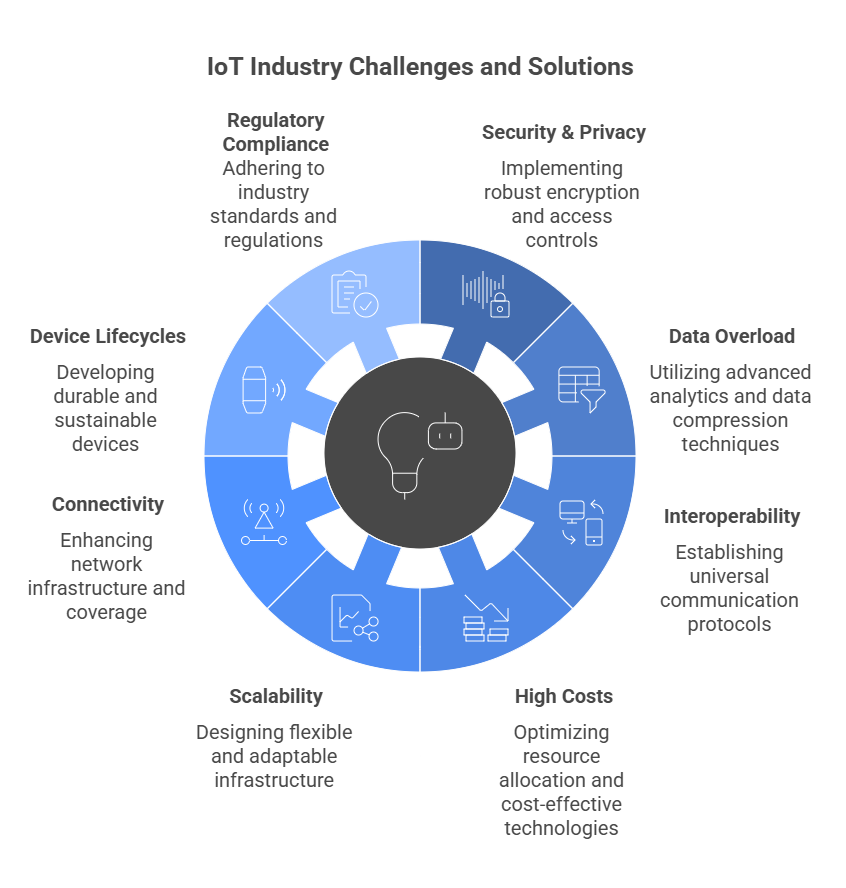The Internet of Things (IoT) has become a backbone of modern industries, from manufacturing and logistics to healthcare, energy, and smart cities. Billions of connected devices are generating valuable data that helps businesses improve efficiency, reduce downtime, and enhance customer experience.
But while IoT promises enormous potential, the industry still faces serious challenges. Issues like security vulnerabilities, interoperability gaps, and high implementation costs prevent many organizations from fully benefiting from IoT solutions. Let’s dive into the key problems in the IoT industry and explore practical solutions to overcome them.

1. Security & Privacy Risks
Security remains the biggest concern in IoT adoption. Many devices ship with weak default passwords, lack encryption, or stop receiving updates after a short lifecycle. Hackers exploit these weaknesses, turning IoT devices into gateways for cyberattacks, ransomware, and botnets.
Solution:
Enforce secure-by-design principles during device development.
Implement strong authentication, encryption, and regular firmware updates.
Use IoT security platforms to detect anomalies and block malicious traffic.
2. Data Overload & Management
With billions of devices connected, IoT generates massive amounts of data. Storing, processing, and analyzing this data becomes difficult, especially for industries like semiconductor fabs, oil and gas, and logistics, where real-time insights are critical.
Solution:
Leverage AI and machine learning for predictive analytics.
Deploy edge computing to process data closer to the source, reducing latency.
Use scalable cloud services for storage and centralized management.
3. Interoperability Issues
The IoT ecosystem is highly fragmented. Devices from different vendors often use different standards and protocols (e.g., MQTT, OPC-UA, Modbus). This lack of standardization makes integration across factories, cities, or healthcare systems very complex.
Solution:
Encourage adoption of open standards for IoT communication.
Use middleware platforms and APIs to connect devices across protocols.
Partner with vendors that support interoperability out-of-the-box.
4. High Implementation Costs
Building an IoT infrastructure requires hardware, sensors, network connectivity, skilled labor, and cloud services. For small and mid-sized companies, these costs can be prohibitive.
Solution:
Adopt pay-as-you-go IoT models and SaaS platforms to reduce upfront investment.
Governments and industry bodies can provide subsidies or incentives for Industry 4.0 adoption.
Focus on ROI-driven IoT projects that demonstrate value quickly.
5. Scalability Challenges
As IoT networks grow, managing thousands or millions of devices becomes more complex. Network congestion, inconsistent firmware updates, and data bottlenecks can lead to failures in critical operations.
Solution:
Deploy centralized IoT management systems.
Use 5G networks for high-speed, low-latency communication.
Implement digital twins to simulate performance before scaling.
6. Network & Connectivity Issues
IoT depends heavily on reliable connectivity. In remote or low-bandwidth regions, devices fail to perform consistently. Latency issues also affect mission-critical applications like remote healthcare monitoring and autonomous vehicles.
Solution:
Deploy edge computing to process data locally when connectivity is weak.
Use private 5G networks for enterprises needing secure, high-speed IoT.
Implement LPWAN (Low-Power Wide-Area Networks) for long-range IoT devices.
7. Short Device Lifecycles
Many IoT devices are not designed for long-term use. Vendors stop supporting firmware updates, creating security risks and forcing costly replacements.
Solution:
Demand vendor accountability for long-term support.
Implement IoT lifecycle management systems for monitoring device health.
Adopt modular IoT designs that allow upgrades without full replacement.
8. Regulatory & Compliance Hurdles
IoT devices often collect sensitive data. Different regions enforce different regulations—such as GDPR in Europe or HIPAA in the U.S. This creates complexity for global businesses deploying IoT solutions.
Solution:
Develop IoT platforms with built-in compliance features.
Adopt standardized security certifications for IoT devices.
Work with partners familiar with global compliance frameworks.
The Future of IoT: Smarter, Safer, and More Connected
Despite these challenges, the IoT industry is rapidly evolving. Emerging technologies like AIoT (Artificial Intelligence + IoT) are enabling smarter, self-learning systems. Blockchain for IoT is gaining traction for secure transactions and traceability. Meanwhile, global standards and government initiatives are paving the way for a more unified ecosystem.
As IoT devices become more energy-efficient, secure, and interoperable, businesses can expect lower costs and higher returns from adoption.
The IoT industry is shaping the future of factories, healthcare, logistics, and smart cities. Yet, businesses must address security, interoperability, scalability, and cost challenges before unlocking its full potential.
With the right mix of AI, edge computing, 5G, and secure IoT frameworks, organizations can overcome today’s hurdles and create a smarter, safer, and more connected world.


